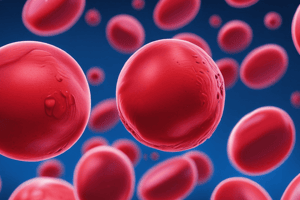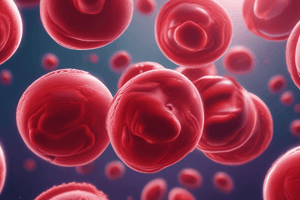Podcast
Questions and Answers
R.B.C. are produced during early embryonic life by the yolk sac, the spleen and liver begin to produce R.B.C.s , during later embryonic life at age 20 , bone (whether flat or long) begins to produce R.B.C.s and flat bones produce R.B.C., such as bones of the skull, ribs and ______.
R.B.C. are produced during early embryonic life by the yolk sac, the spleen and liver begin to produce R.B.C.s , during later embryonic life at age 20 , bone (whether flat or long) begins to produce R.B.C.s and flat bones produce R.B.C., such as bones of the skull, ribs and ______.
sternum
The increase of R.B.C.s count under normal value is called ______.
The increase of R.B.C.s count under normal value is called ______.
Polycythemia
R.B.C. are produced during early embryonic life by the ______, the spleen and liver begin to produce R.B.C.s , during later embryonic life at age 20 , bone (whether flat or long) begins to produce R.B.C.s and flat bones produce R.B.C., such as bones of the skull, ribs and sternum.
R.B.C. are produced during early embryonic life by the ______, the spleen and liver begin to produce R.B.C.s , during later embryonic life at age 20 , bone (whether flat or long) begins to produce R.B.C.s and flat bones produce R.B.C., such as bones of the skull, ribs and sternum.
yolk sac
The increase of R.B.C.s count under normal value is called ______.
The increase of R.B.C.s count under normal value is called ______.
Flashcards are hidden until you start studying
Study Notes
Red Blood Cell (R.B.C.) Production
- R.B.C.s are initially produced by the yolk sac during early embryonic life.
- As development progresses, the spleen and liver take over as the primary sites for R.B.C. production.
- Around the age of 20 weeks of gestation, bone marrow begins to produce R.B.C.s, transitioning to the primary source for R.B.C. generation postnatally.
- Flat bones, such as those in the skull, ribs, and sternum, are significant contributors to R.B.C. production in adults.
Increase in R.B.C. Count
- An increase in R.B.C. count beyond the normal range is referred to as polycythemia.
- Polycythemia can occur due to various physiological or pathological conditions, leading to increased blood viscosity and potential complications.
Studying That Suits You
Use AI to generate personalized quizzes and flashcards to suit your learning preferences.




